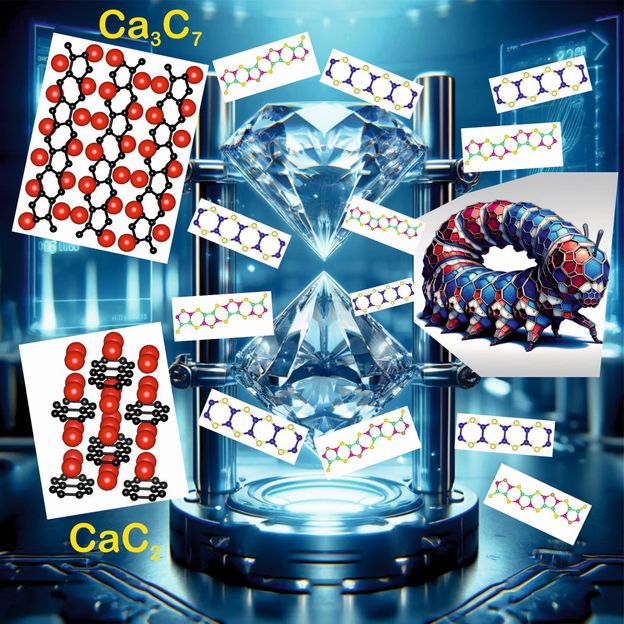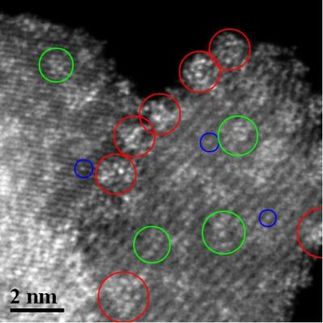Synthesis of new forms of carbon compounds
In a groundbreaking study, researchers have gained new insights in the field of high-pressure carbon chemistry
Advertisement
Researchers at the University of Bayreuth synthesized two new carbides – compounds of carbon and another chemical element – with unique structures. The results may provide an unexpected explanation of wide spread of polycyclic aromatic hydrocarbons in Universe.

Art presentation of the discoveries. Novel carbides CaC2 and Ca3C7, containing deprotonated carbon nanoribbons were synthesized at high pressures and temperatures in a diamond anvil cell. Their crystal structures are shown in the left (Ca atoms are red, nanoribbons are black. In the “confetti” of the nanoribbons crystallographically different carbon atoms are depicted in different colors). These novel materials can exist under the conditions found in the interiors of planets, and their hydrolysis within planetary bodies, on their surfaces, or in their atmospheres, may serve as a source of polycyclic aromatic hydrocarbons, providing chemical building blocks for the creation of life (symbolically represented by an AI-generated fantastic creature, the figure to the right).
UBT/Leonid Dubrovinsky
Under the leadership of Prof. Dr. Leonid Dubrovinsky from the Bavarian Geoinstitute and Prof. Dr. Natalia Dubrovinskaia from the Laboratory of Crystallography at the University of Bayreuth, researchers have synthesized new carbon compounds which have structural elements similar to those of complex organic molecules, but deprotonated (i.e. do not contain hydrogen).
To do this, the researchers used diamond anvil cells that compressed the tiny calcium carbide crystals to pressures in the three-digit gigapascal range and simultaneously heated them to temperatures of around 3,000 °C. These conditions correspond to those at a depth of 2.900 km in the Earth's interior. The change in pressure and temperature caused the calcium carbide to form two new carbides: high-pressure polymorph of CaC2 and Ca3C7.
Although the high-pressure polymorph of CaC2 has the same chemical composition as the starting material, it differs from it in the spatial arrangement of the atoms and in its chemical properties. The polymorph possesses carbon chains that can exist under conditions that far exceed those known for the existence of conventional organic compounds. The formation of such compounds under the conditions in the interior of planets could even have played a role in the origin of life, because they could be the origin of hydrocarbons.
The compound with the chemical formula Ca3C7 has never been observed before, so that its synthesis and structure elucidation represent a significant step forward in understanding the behaviour of carbon-based materials under extreme conditions.
Prof. Dr. Leonid Dubrovinsky, the lead researcher of the study, explained: "Our findings not only expand the boundaries of known carbon chemistry but also provide a new perspective on how complex carbon structures could exist in the deep Earth and potentially in other planetary bodies"
"The similarities between these high-pressure carbides and deprotonated metal-organic compounds open up exciting possibilities for designing novel materials with unique electronic, magnetic, and optical properties," added Prof. Dr. Natalia Dubrovinskaia.
The research work was carried out in international collaboration by scientists from the Bavarian Geoinstitute and the Laboratory of Crystallography at the University of Bayreuth, the German Electron Synchrotron (DESY), the University of Cologne, the University of Edinburgh, Goethe University Frankfurt, the University of Chicago, the European Synchrotron Radiation Facility and Linköping University.
Original publication
Saiana Khandarkhaeva, Timofey Fedotenko, Alena Aslandukova, Fariia Iasmin Akbar, Maxim Bykov, Dominique Laniel et al.; "Extending carbon chemistry at high-pressure by synthesis of CaC2 and Ca3C7 with deprotonated polyacene- and para-poly(indenoindene)-like nanoribbons"; Nature Communications, Volume 15, 2024-4-2
Other news from the department science
Most read news
More news from our other portals
See the theme worlds for related content
Topic world Synthesis
Chemical synthesis is at the heart of modern chemistry and enables the targeted production of molecules with specific properties. By combining starting materials in defined reaction conditions, chemists can create a wide range of compounds, from simple molecules to complex active ingredients.

Topic world Synthesis
Chemical synthesis is at the heart of modern chemistry and enables the targeted production of molecules with specific properties. By combining starting materials in defined reaction conditions, chemists can create a wide range of compounds, from simple molecules to complex active ingredients.


































































